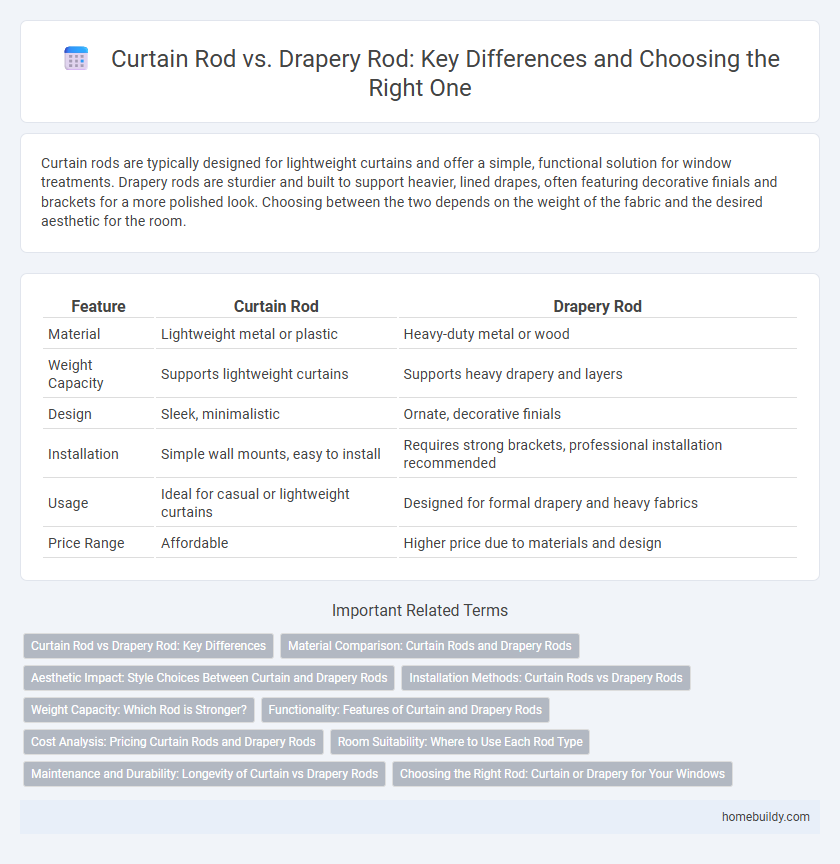Curtain rods are typically designed for lightweight curtains and offer a simple, functional solution for window treatments. Drapery rods are sturdier and built to support heavier, lined drapes, often featuring decorative finials and brackets for a more polished look. Choosing between the two depends on the weight of the fabric and the desired aesthetic for the room.
Table of Comparison
| Feature | Curtain Rod | Drapery Rod |
|---|---|---|
| Material | Lightweight metal or plastic | Heavy-duty metal or wood |
| Weight Capacity | Supports lightweight curtains | Supports heavy drapery and layers |
| Design | Sleek, minimalistic | Ornate, decorative finials |
| Installation | Simple wall mounts, easy to install | Requires strong brackets, professional installation recommended |
| Usage | Ideal for casual or lightweight curtains | Designed for formal drapery and heavy fabrics |
| Price Range | Affordable | Higher price due to materials and design |
Curtain Rod vs Drapery Rod: Key Differences
Curtain rods are typically slimmer and designed for lightweight fabrics, while drapery rods are heavier and constructed to support thicker, heavier drapes. Curtain rods often have simple finials and come in adjustable lengths for ease of installation, whereas drapery rods feature sturdy brackets and decorative, elaborate finials to enhance window treatments. The choice between curtain rod and drapery rod depends on fabric weight, window size, and desired aesthetic impact.
Material Comparison: Curtain Rods and Drapery Rods
Curtain rods commonly use lightweight metals like aluminum or steel, offering durability and ease of installation, while drapery rods often feature heavier materials such as wrought iron or wood to support thicker, heavier fabrics. The material choice directly impacts weight capacity and aesthetic appeal, with metal rods providing a sleek, modern look and wooden or wrought iron rods adding a more traditional or rustic feel. Understanding these material differences helps in selecting the right rod based on fabric weight and design preference for optimal function and style.
Aesthetic Impact: Style Choices Between Curtain and Drapery Rods
Curtain rods typically feature a minimalist design that complements lightweight fabrics, enhancing a room's casual or modern aesthetic. Drapery rods are often more ornate and sturdy, designed to support heavier drapes and add a formal, elegant touch to interior decor. Choosing between curtain and drapery rods significantly influences the overall style impact, with curtain rods offering subtlety while drapery rods provide a bold decorative statement.
Installation Methods: Curtain Rods vs Drapery Rods
Curtain rods typically use simple wall brackets and screw-in installation, allowing for easy mounting and removal, making them suitable for lightweight fabrics. Drapery rods require more robust hardware, including center supports and sometimes ceiling mounts, to handle heavier drapery fabrics and complex designs like multi-rod systems. Installation methods vary to accommodate weight, fabric type, and decorative needs, with drapery rods demanding precise alignment and reinforcement for stability.
Weight Capacity: Which Rod is Stronger?
Curtain rods typically have a higher weight capacity compared to drapery rods, as they are designed to support heavier fabrics and multiple layers of curtains. Made from robust materials like steel or aluminum, curtain rods can hold weights ranging from 15 to 50 pounds or more, depending on thickness and mounting hardware. Drapery rods, often lighter and more decorative, are better suited for lighter fabrics and usually support weights under 20 pounds, making curtain rods the stronger choice for heavy curtains.
Functionality: Features of Curtain and Drapery Rods
Curtain rods are designed for lightweight fabrics and typically feature simple, minimalist brackets and finials to support standard curtains with ease. Drapery rods, on the other hand, are sturdier and often equipped with additional features such as double brackets for lining and heavy drapery weights to accommodate thicker, heavier fabrics. The functionality of drapery rods also includes options for traverse systems and motorized controls, enhancing their suitability for formal window treatments requiring frequent adjustment.
Cost Analysis: Pricing Curtain Rods and Drapery Rods
Curtain rods typically range from $10 to $50, offering budget-friendly options made from materials like aluminum, plastic, or basic steel. Drapery rods, designed for heavier fabric and more decorative styles, often cost between $30 and $150, reflecting their robust construction and premium finishes. Choosing between curtain rods and drapery rods depends on weight support needs and design preference, with cost differences influenced by material quality and rod features.
Room Suitability: Where to Use Each Rod Type
Curtain rods are ideal for lightweight fabrics and casual room settings such as bedrooms and kitchens, offering easy installation and flexible styling options. Drapery rods, designed for heavier fabrics and formal drapery panels, suit living rooms, dining rooms, and spaces requiring a more polished, elegant appearance. Choosing the right rod depends on fabric weight, room formality, and overall decor style to ensure functionality and aesthetic harmony.
Maintenance and Durability: Longevity of Curtain vs Drapery Rods
Curtain rods typically feature lightweight materials such as aluminum or steel, offering moderate durability and requiring regular cleaning to prevent dust build-up, ensuring extended lifespan. Drapery rods, often constructed from heavy-duty metals like wrought iron or brass, provide superior strength and resistance to wear, making them more suitable for heavy fabric drapes and reducing the frequency of maintenance. Proper installation and occasional inspection of mounting brackets significantly enhance the longevity of both curtain and drapery rods, with drapery rods generally outlasting curtain rods due to their robust construction.
Choosing the Right Rod: Curtain or Drapery for Your Windows
Curtain rods typically support lighter, sheer fabrics and are designed for functional ease, while drapery rods are sturdier and crafted to hold heavier, layered drapes. When choosing between a curtain rod or drapery rod, consider the weight and style of your window treatments along with the desired aesthetic and window size. Opting for the correct rod ensures proper support, smooth operation, and enhances the overall look of your windows.
Curtain rod vs Drapery rod Infographic

 homebuildy.com
homebuildy.com